
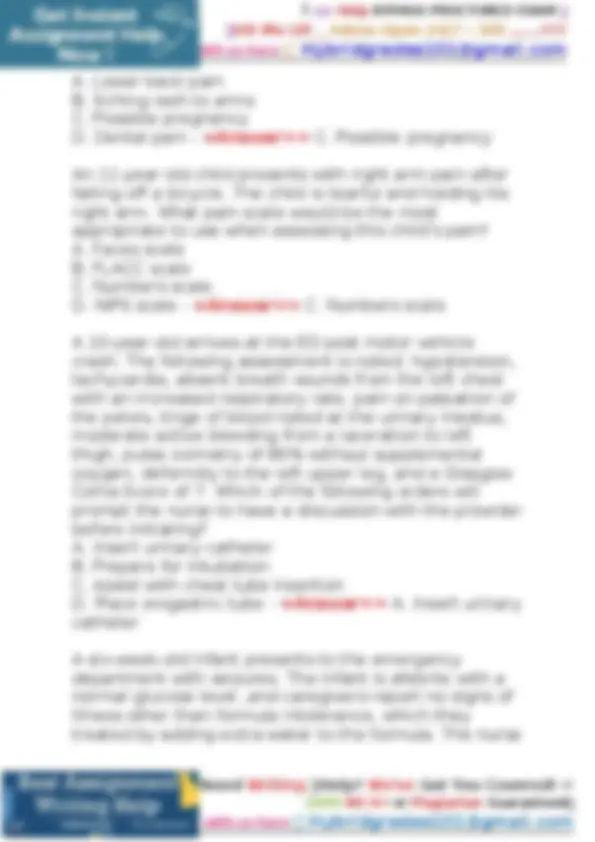
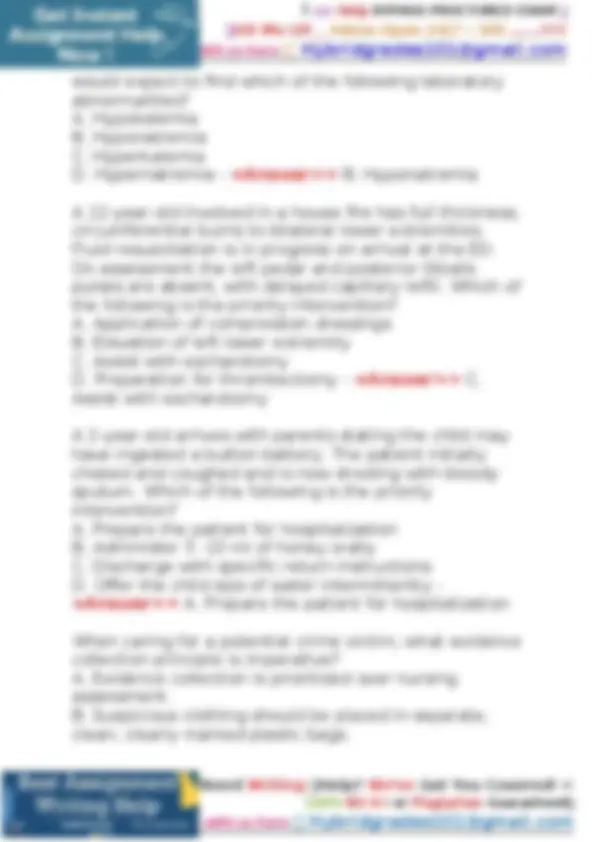
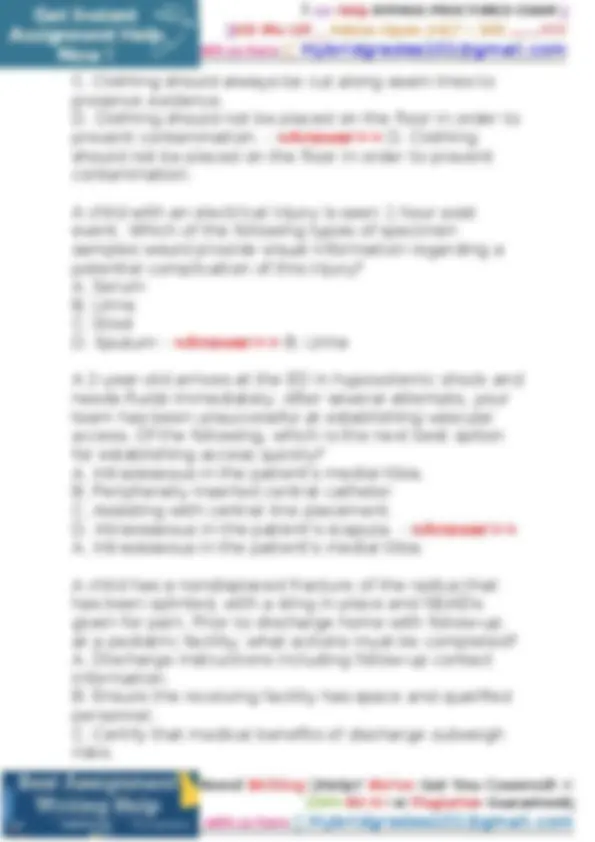
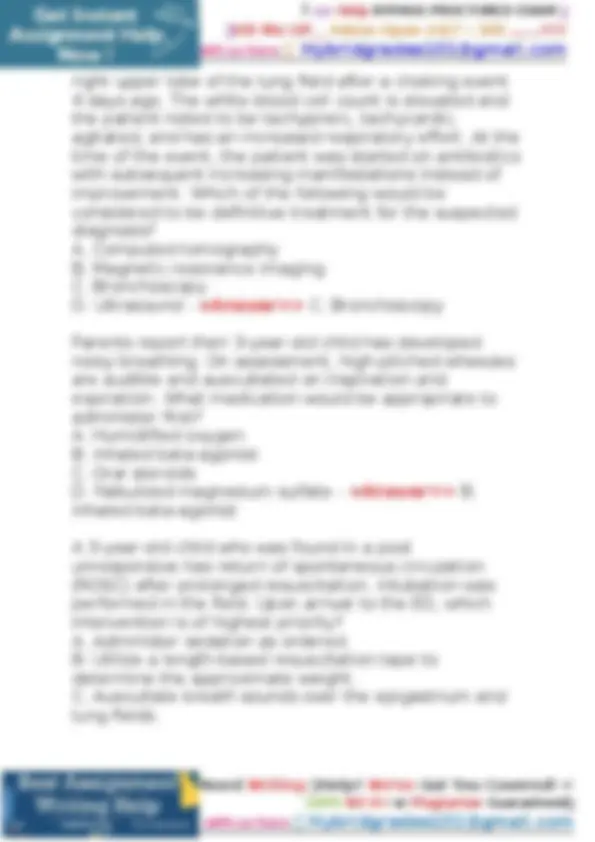
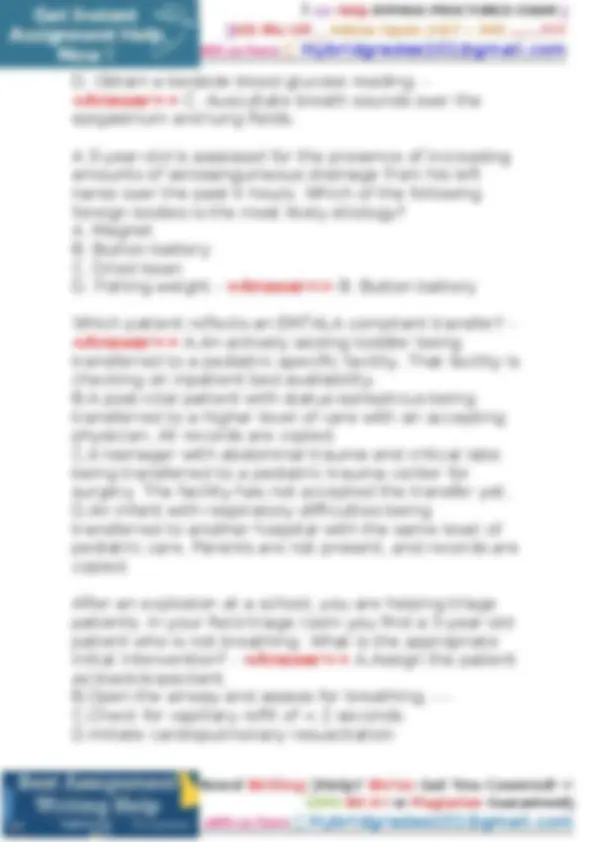
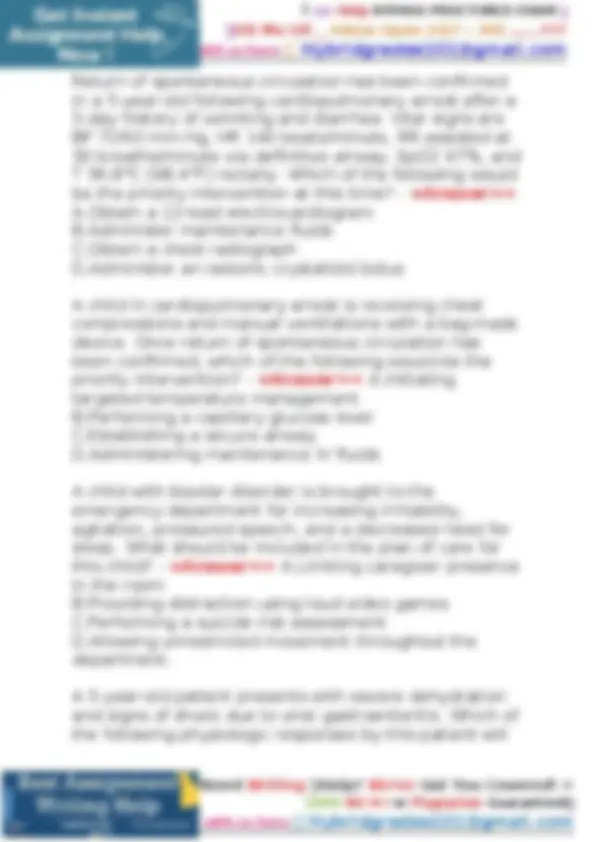
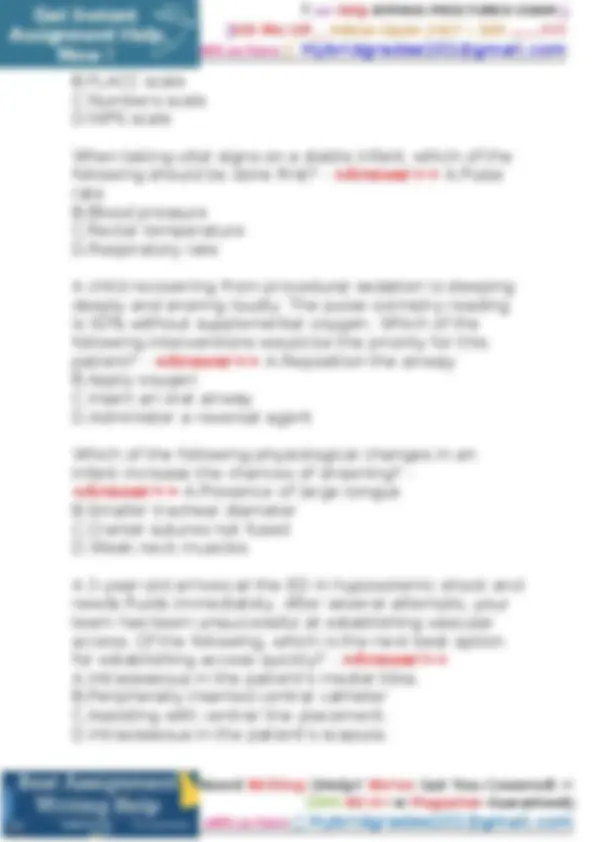
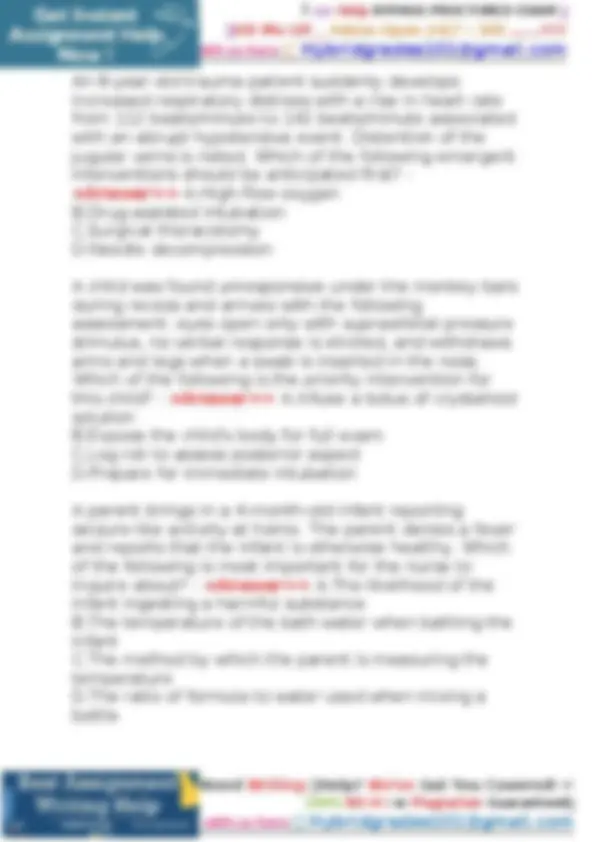
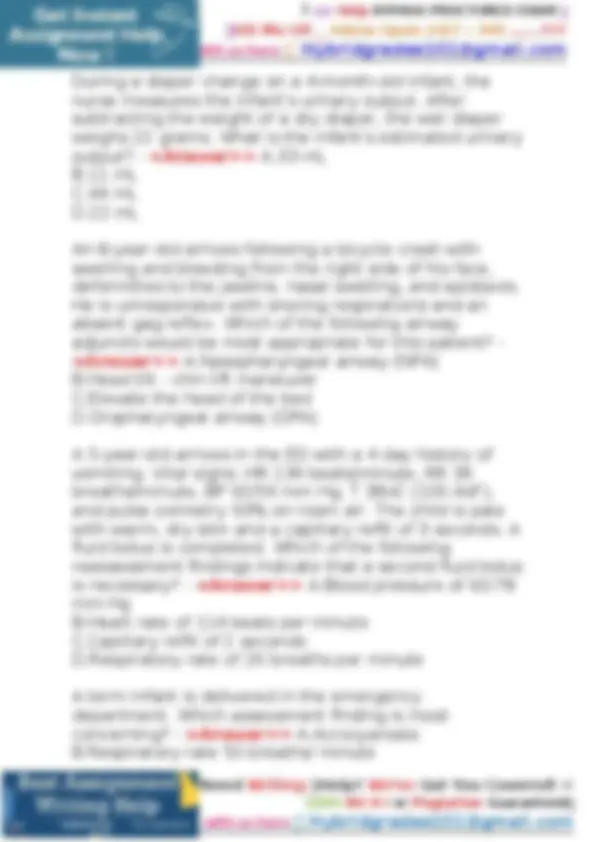
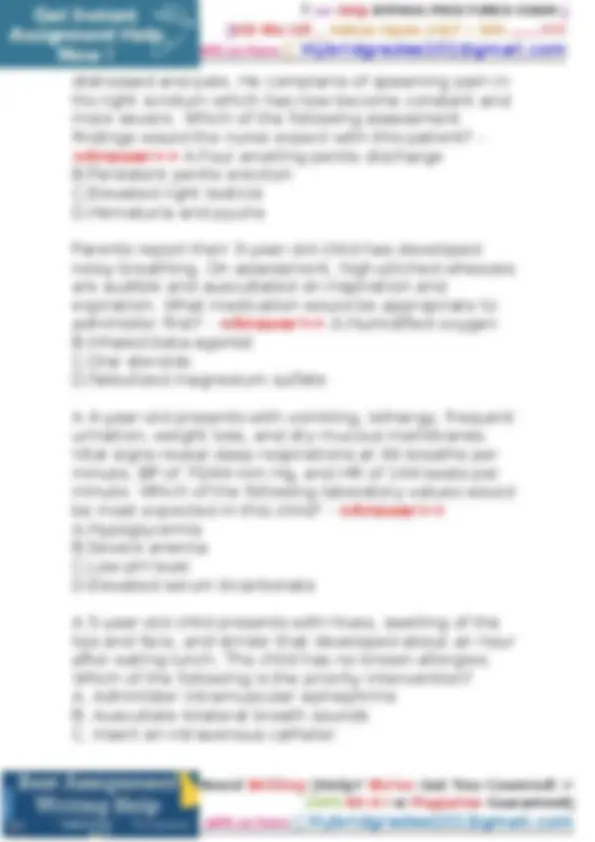
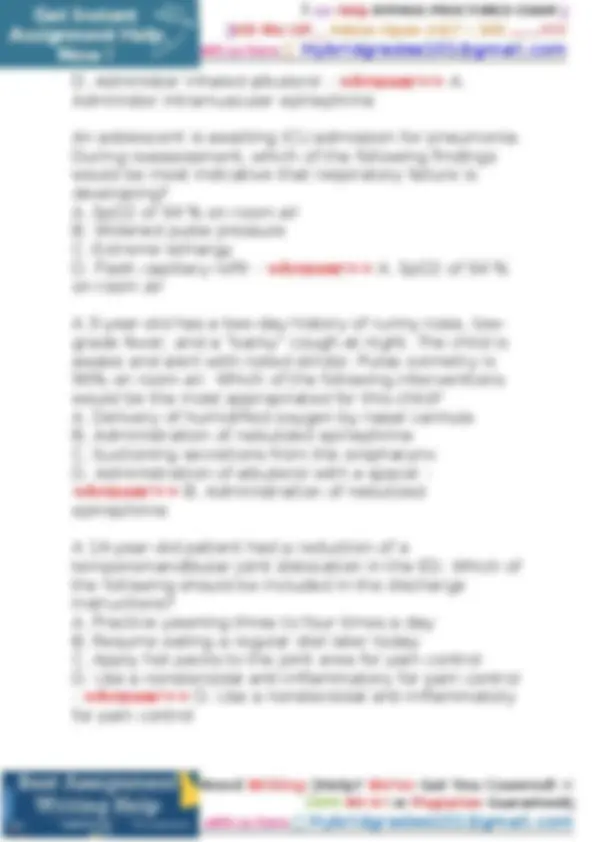
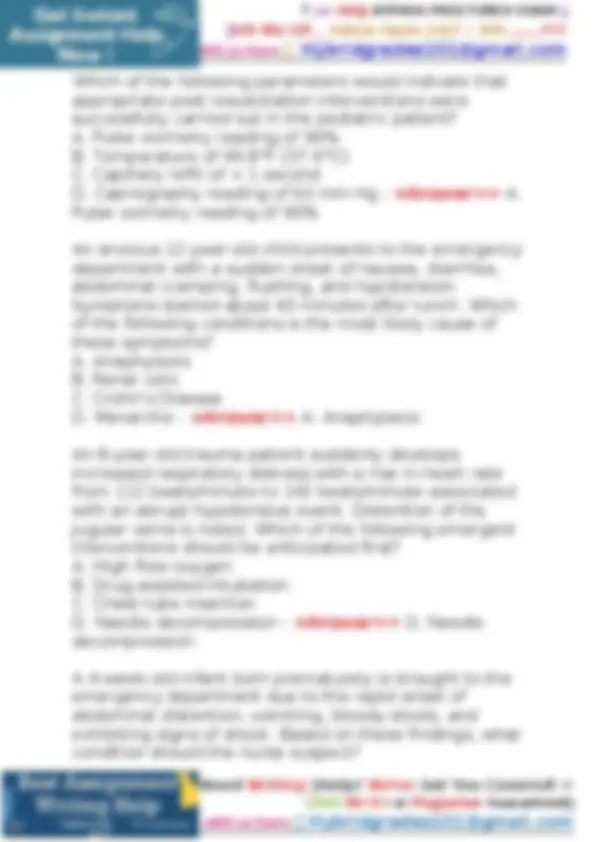
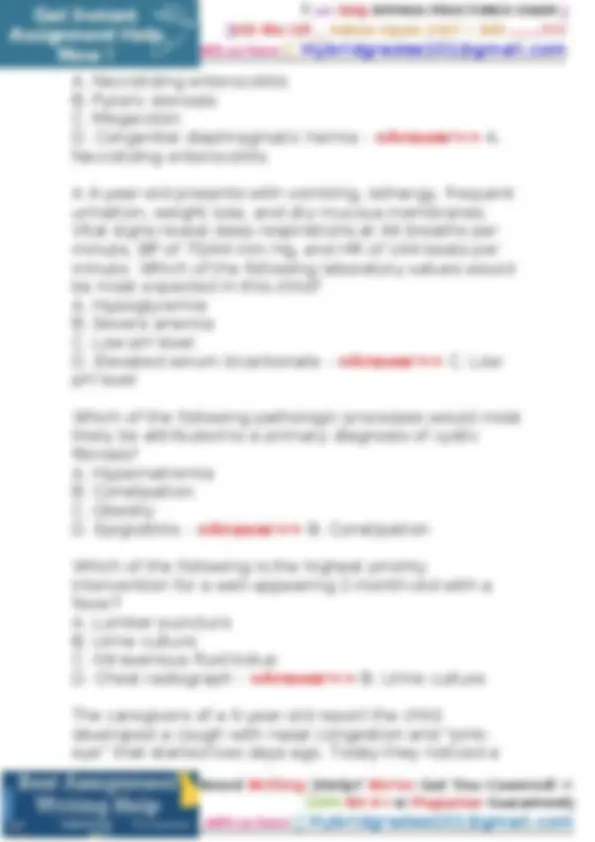
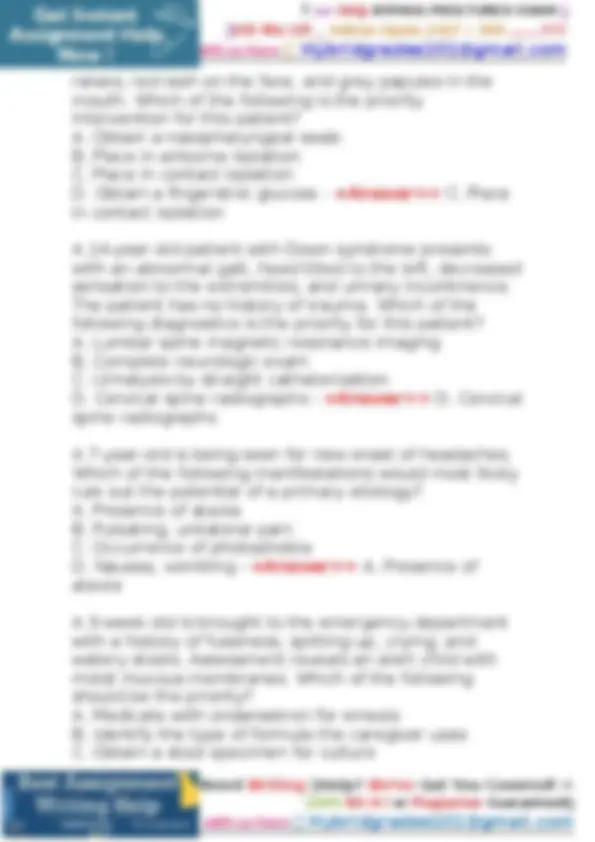
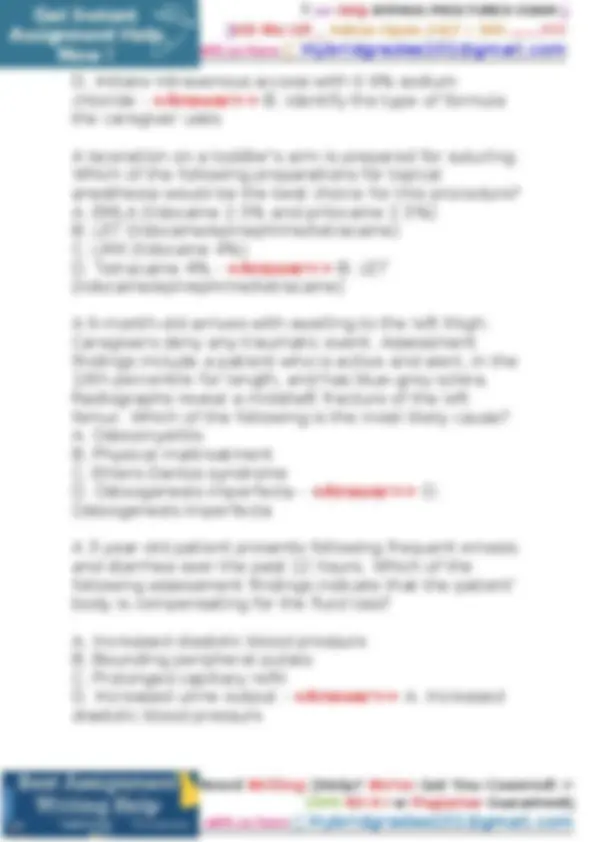
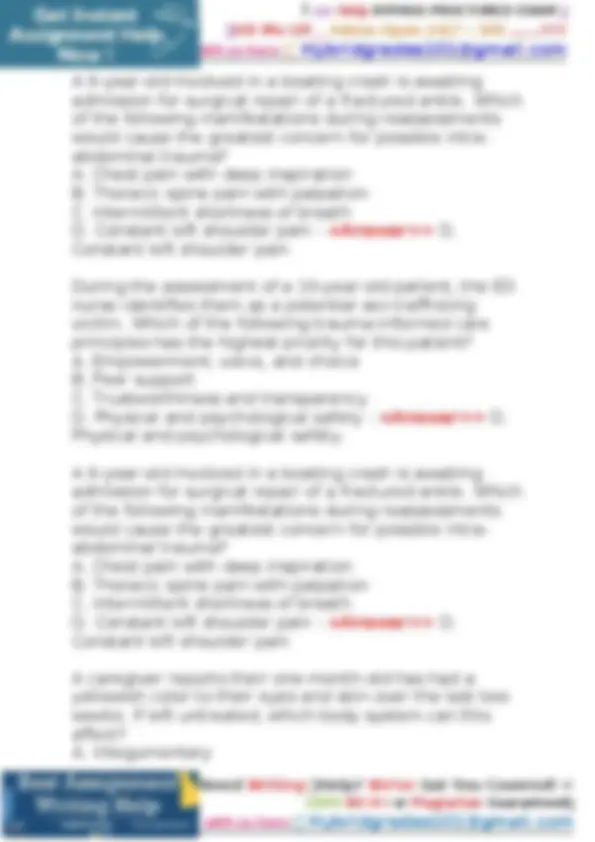
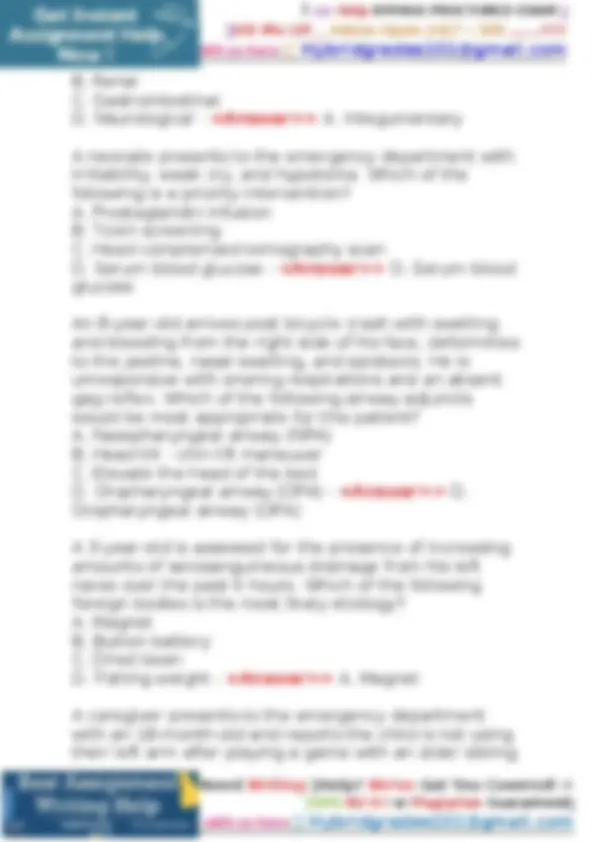
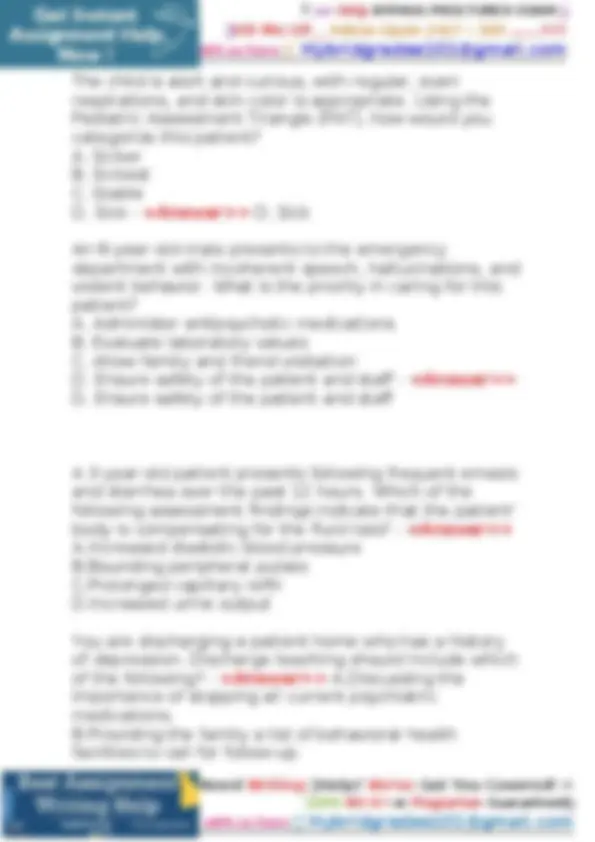
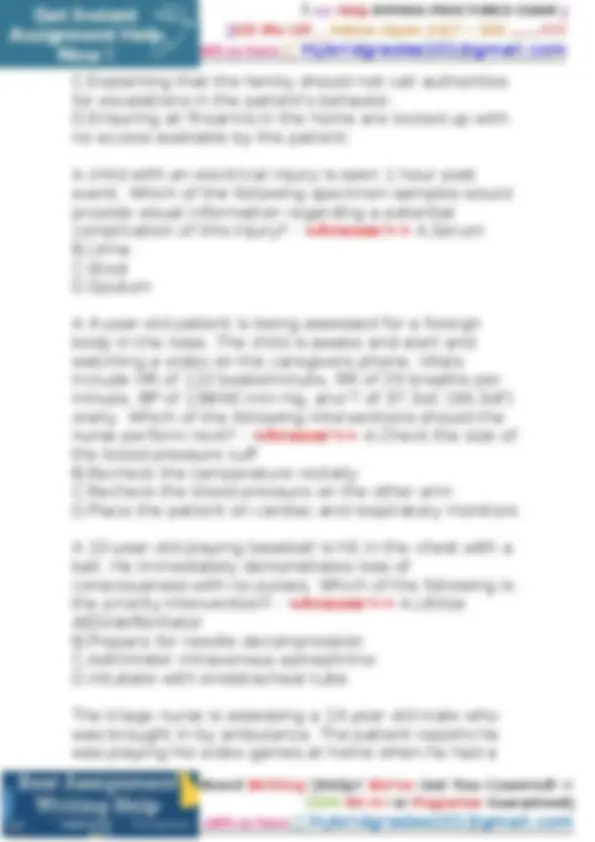
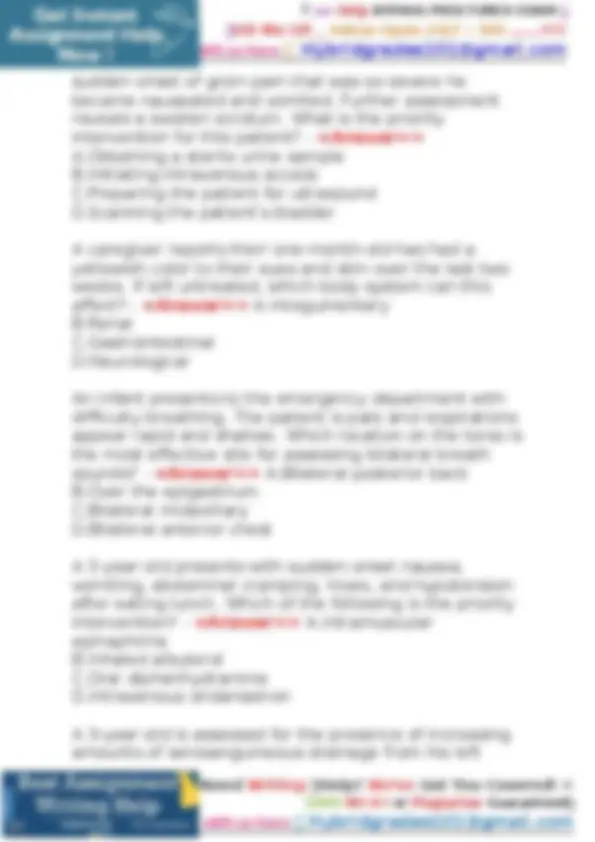
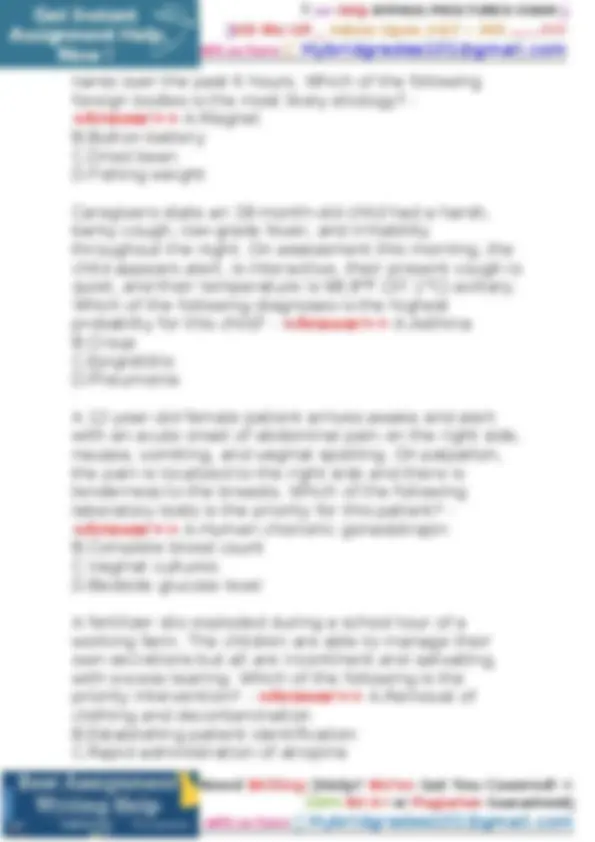
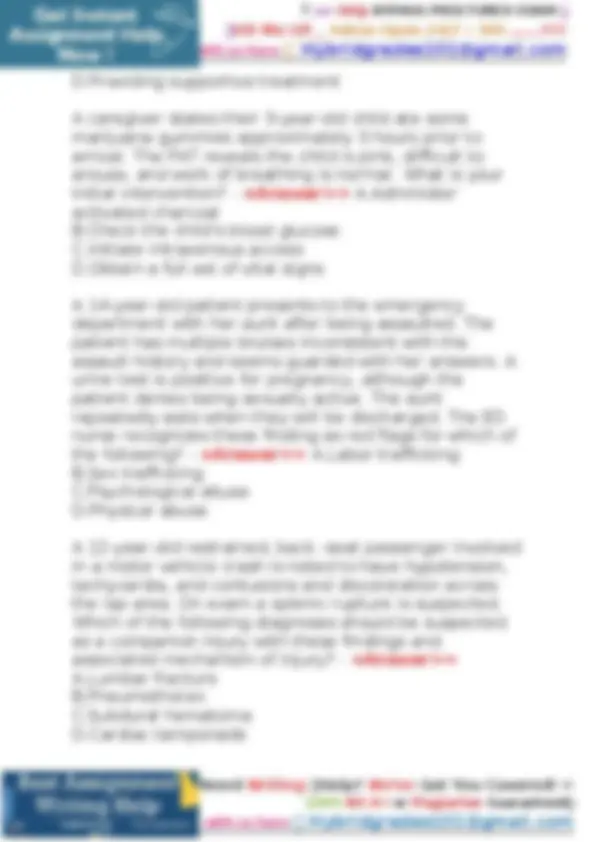




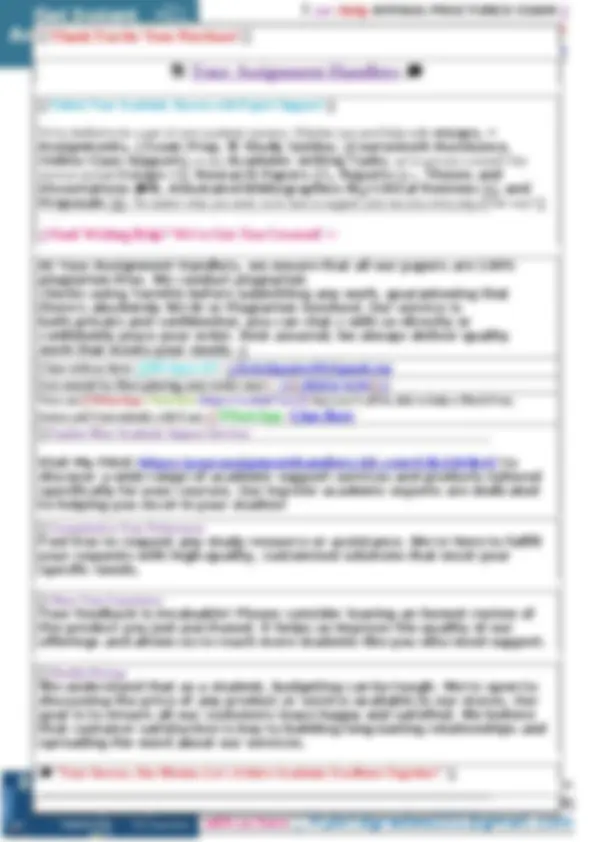



Study with the several resources on Docsity

Earn points by helping other students or get them with a premium plan


Prepare for your exams
Study with the several resources on Docsity

Earn points to download
Earn points by helping other students or get them with a premium plan
Community
Ask the community for help and clear up your study doubts
Discover the best universities in your country according to Docsity users
Free resources
Download our free guides on studying techniques, anxiety management strategies, and thesis advice from Docsity tutors
A series of multiple-choice questions and answers related to the enpc (emergency nursing pediatric course) certification exam. It covers various topics relevant to pediatric emergency care, including assessment, management of common pediatric emergencies, and critical care interventions. Designed to help students prepare for the enpc certification exam by providing practice questions and answers.
Typology: Exams
1 / 36

This page cannot be seen from the preview
Don't miss anything!





























Course Title and Number: ATLS Written Examination & Practical Skills Assessment Exam Title: ATLS Exam Exam Date: Exam 2025- 2026 Instructor: ____ [Insert Instructor’s Name] _______ Student Name: ___ [Insert Student’s Name] _____ Student ID: ____ [Insert Student ID] _____________
Time: - ____ Hours: ___ Minutes
**1. Read each question carefully.
📱Hit Me UP__ Inbox Open 24/7 – 365 …...!!!! 📱 Chat with us here: 📱 Hybridgrades101@gmail.com
th
Read All Instructions Carefully and Answer All the Questions Correctly Good Luck: - A 2-year-old child is seen with acute respiratory distress after playing alone. Caregiver statements indicate the child was found playing with irregular, ½ - ¾ inch sized pieces of a game. Which of the following assessment findings would most likely be expected for this situation? A. Audible wheezing and retractions B. Inspiratory stridor and coughing C. Grunting respirations and tachypnea D. Quiet tachypnea and coarse crackles - =Answer>> B. Inspiratory stridor and coughing A 15-year-old presents alone requesting care. Which of the following chief complaints would most likely be considered legal or appropriate to treat without parental consent? Need Writing 📱Help? We've Got You Covered! ✍ 100% NO A I or Plagiarism Guaranteed📱 Click Here To <
NOW.!!!
📱Hit Me UP__ Inbox Open 24/7 – 365 …...!!!! 📱 Chat with us here: 📱 Hybridgrades101@gmail.com would expect to find which of the following laboratory abnormalities? A. Hypokalemia B. Hyponatremia C. Hyperkalemia D. Hypernatremia - =Answer>> B. Hyponatremia A 12-year-old involved in a house fire has full thickness, circumferential burns to bilateral lower extremities. Fluid resuscitation is in progress on arrival at the ED. On assessment the left pedal and posterior tibialis pulses are absent, with delayed capillary refill. Which of the following is the priority intervention? A. Application of compression dressings B. Elevation of left lower extremity C. Assist with escharotomy D. Preparation for thrombectomy - =Answer>> C. Assist with escharotomy A 2-year-old arrives with parents stating the child may have ingested a button battery. The patient initially choked and coughed and is now drooling with bloody sputum. Which of the following is the priority intervention? A. Prepare the patient for hospitalization B. Administer 5 -10 ml of honey orally C. Discharge with specific return instructions D. Offer the child sips of water intermittently - =Answer>> A. Prepare the patient for hospitalization When caring for a potential crime victim, what evidence collection principle is imperative? A. Evidence collection is prioritized over nursing assessment. B. Suspicious clothing should be placed in separate, clean, clearly marked plastic bags. Need Writing 📱Help? We've Got You Covered! ✍ 100% NO A I or Plagiarism Guaranteed📱
📱Hit Me UP__ Inbox Open 24/7 – 365 …...!!!! 📱 Chat with us here: 📱 Hybridgrades101@gmail.com C. Clothing should always be cut along seam lines to preserve evidence. D. Clothing should not be placed on the floor in order to prevent contamination. - =Answer>> D. Clothing should not be placed on the floor in order to prevent contamination. A child with an electrical injury is seen 1 hour post event. Which of the following types of specimen samples would provide visual information regarding a potential complication of this injury? A. Serum B. Urine C. Stool D. Sputum - =Answer>> B. Urine A 2-year-old arrives at the ED in hypovolemic shock and needs fluids immediately. After several attempts, your team has been unsuccessful at establishing vascular access. Of the following, which is the next best option for establishing access quickly? A. Intraosseous in the patient's medial tibia. B. Peripherally inserted central catheter C. Assisting with central line placement. D. Intraosseous in the patient's scapula. - =Answer>> A. Intraosseous in the patient's medial tibia. A child has a nondisplaced fracture of the radius that has been splinted, with a sling in place and NSAIDs given for pain. Prior to discharge home with follow-up at a pediatric facility, what actions must be completed? A. Discharge instructions including follow-up contact information. B. Ensure the receiving facility has space and qualified personnel. C. Certify that medical benefits of discharge outweigh risks. Need Writing 📱Help? We've Got You Covered! ✍ 100% NO A I or Plagiarism Guaranteed📱
📱Hit Me UP__ Inbox Open 24/7 – 365 …...!!!! 📱 Chat with us here: 📱 Hybridgrades101@gmail.com D. Bilateral anterior chest - =Answer>> C. Bilateral midaxillary A child was found unresponsive under the monkey bars during recess and arrives with the following assessment: eyes open only with supraorbital pressure stimulus, no verbal response is elicited, and withdraws arms and legs when a swab is inserted in the nose. Which of the following is the priority intervention for this child? A. Infuse a bolus of crystalloid solution B. Expose the child's body for full exam C. Log roll to assess posterior aspect D. Prepare for immediate intubation - =Answer>> D. Prepare for immediate intubation A 5-year-old presents with sudden onset nausea, vomiting, abdominal cramping, hives, and hypotension after eating lunch. Which of the following is the priority intervention? A. Intramuscular epinephrine B. Inhaled albuterol C. Oral diphenhydramine D. Intravenous ondansetron - =Answer>> A. Intramuscular epinephrine A 12-year-old is being prepped for surgical intervention of acute appendicitis. Which of the following intravenous medication orders should the nurse question? A. Morphine B. Acetaminophen C. Hydromorphone D. Ketorolac - =Answer>> D. Ketorolac An 18-month-old is seen for fever, slight circumoral cyanosis, and wheezing noted on auscultation in the Need Writing 📱Help? We've Got You Covered! ✍ 100% NO A I or Plagiarism Guaranteed📱
📱Hit Me UP__ Inbox Open 24/7 – 365 …...!!!! 📱 Chat with us here: 📱 Hybridgrades101@gmail.com right upper lobe of the lung field after a choking event 4 days ago. The white blood cell count is elevated and the patient noted to be tachypneic, tachycardic, agitated, and has an increased respiratory effort. At the time of the event, the patient was started on antibiotics with subsequent increasing manifestations instead of improvement. Which of the following would be considered to be definitive treatment for the suspected diagnosis? A. Computed tomography B. Magnetic resonance imaging C. Bronchoscopy D. Ultrasound - =Answer>> C. Bronchoscopy Parents report their 3-year-old child has developed noisy breathing. On assessment, high-pitched wheezes are audible and auscultated on inspiration and expiration. What medication would be appropriate to administer first? A. Humidified oxygen B. Inhaled beta-agonist C. Oral steroids D. Nebulized magnesium sulfate - =Answer>> B. Inhaled beta-agonist A 3-year-old child who was found in a pool unresponsive has return of spontaneous circulation (ROSC) after prolonged resuscitation. Intubation was performed in the field. Upon arrival to the ED, which intervention is of highest priority? A. Administer sedation as ordered. B. Utilize a length-based resuscitation tape to determine the approximate weight. C. Auscultate breath sounds over the epigastrium and lung fields. Need Writing 📱Help? We've Got You Covered! ✍ 100% NO A I or Plagiarism Guaranteed📱
📱Hit Me UP__ Inbox Open 24/7 – 365 …...!!!! 📱 Chat with us here: 📱 Hybridgrades101@gmail.com Return of spontaneous circulation has been confirmed in a 5-year-old following cardiopulmonary arrest after a 5-day history of vomiting and diarrhea. Vital signs are BP 72/60 mm Hg, HR 140 beats/minute, RR assisted at 30 breaths/minute via definitive airway, SpO2 97%, and T 36.8°C (98.4°F) rectally. Which of the following would be the priority intervention at this time? - =Answer>> A.Obtain a 12-lead electrocardiogram B.Administer maintenance fluids C.Obtain a chest radiograph D.Administer an isotonic crystalloid bolus A child in cardiopulmonary arrest is receiving chest compressions and manual ventilations with a bag-mask device. Once return of spontaneous circulation has been confirmed, which of the following would be the priority intervention? - =Answer>> A.Initiating targeted temperature management B.Performing a capillary glucose level C.Establishing a secure airway D.Administering maintenance IV fluids A child with bipolar disorder is brought to the emergency department for increasing irritability, agitation, pressured speech, and a decreased need for sleep. What should be included in the plan of care for this child? - =Answer>> A.Limiting caregiver presence in the room B.Providing distraction using loud video games C.Performing a suicide risk assessment D.Allowing unrestricted movement throughout the department. A 5-year-old patient presents with severe dehydration and signs of shock due to viral gastroenteritis. Which of the following physiologic responses by this patient will Need Writing 📱Help? We've Got You Covered! ✍ 100% NO A I or Plagiarism Guaranteed📱
📱Hit Me UP__ Inbox Open 24/7 – 365 …...!!!! 📱 Chat with us here: 📱 Hybridgrades101@gmail.com have the greatest impact on improving their cardiac output? - =Answer>> A.Increased heart rate B.Decreased preload C.Increased afterload D.Decreased contractility An 8-month-old arrives with a 12-hour history of intermittent abdominal pain, non-bilious vomiting, and a low grade fever. On assessment the child is intermittently inconsolable followed by periods of normal activity. A sausage-shaped mass is noted during palpation of the abdomen. The nurse should prepare for which of the following? - =Answer>> A.Gastric tube insertion B.Enema with air C.Surgical intervention D.Computerized tomography What is the first step in the care of the newly born infant? - =Answer>> A.Suction the nose and mouth B.Measure pulse oximetry C.Calculate an APGAR score D.Warm, dry, and stimulate A 2-year-old arrives with a 2-day history of vomiting and diarrhea. The patient has a fever of 38.4oC (101.2°F), resting HR of 152 beats/minute, RR of 34 breaths/minute, and blood pressure of 94/ 56 mm Hg. Assessment reveals a capillary refill time of > 5 seconds. Which of the following would be most indicative of the need for intravenous rehydration therapy for this patient? - =Answer>> A.Capillary refill B.Blood pressure C.Pulse rate D.Respiratory rate Need Writing 📱Help? We've Got You Covered! ✍ 100% NO A I or Plagiarism Guaranteed📱
📱Hit Me UP__ Inbox Open 24/7 – 365 …...!!!! 📱 Chat with us here: 📱 Hybridgrades101@gmail.com B.FLACC scale C.Numbers scale D.NIPS scale When taking vital signs on a stable infant, which of the following should be done first? - =Answer>> A.Pulse rate B.Blood pressure C.Rectal temperature D.Respiratory rate A child recovering from procedural sedation is sleeping deeply and snoring loudly. The pulse oximetry reading is 92% without supplemental oxygen. Which of the following interventions would be the priority for this patient? - =Answer>> A.Reposition the airway B.Apply oxygen C.Insert an oral airway D.Administer a reversal agent Which of the following physiological changes in an infant increase the chances of drowning? - =Answer>> A.Presence of large tongue B.Smaller tracheal diameter C.Cranial sutures not fused D.Weak neck muscles A 2-year-old arrives at the ED in hypovolemic shock and needs fluids immediately. After several attempts, your team has been unsuccessful at establishing vascular access. Of the following, which is the next best option for establishing access quickly? - =Answer>> A.Intraosseous in the patient's medial tibia. B.Peripherally inserted central catheter C.Assisting with central line placement. D.Intraosseous in the patient's scapula. Need Writing 📱Help? We've Got You Covered! ✍ 100% NO A I or Plagiarism Guaranteed📱
📱Hit Me UP__ Inbox Open 24/7 – 365 …...!!!! 📱 Chat with us here: 📱 Hybridgrades101@gmail.com An 8-year-old trauma patient suddenly develops increased respiratory distress with a rise in heart rate from 112 beats/minute to 142 beats/minute associated with an abrupt hypotensive event. Distention of the jugular veins is noted. Which of the following emergent interventions should be anticipated first? - =Answer>> A.High-flow oxygen B.Drug-assisted intubation C.Surgical thoracotomy D.Needle decompression A child was found unresponsive under the monkey bars during recess and arrives with the following assessment: eyes open only with supraorbital pressure stimulus, no verbal response is elicited, and withdraws arms and legs when a swab is inserted in the nose. Which of the following is the priority intervention for this child? - =Answer>> A.Infuse a bolus of crystalloid solution B.Expose the child's body for full exam C.Log roll to assess posterior aspect D.Prepare for immediate intubation A parent brings in a 4-month-old infant reporting seizure-like activity at home. The parent denies a fever and reports that the infant is otherwise healthy. Which of the following is most important for the nurse to inquire about? - =Answer>> A.The likelihood of the infant ingesting a harmful substance B.The temperature of the bath water when bathing the infant C.The method by which the parent is measuring the temperature D.The ratio of formula to water used when mixing a bottle Need Writing 📱Help? We've Got You Covered! ✍ 100% NO A I or Plagiarism Guaranteed📱
📱Hit Me UP__ Inbox Open 24/7 – 365 …...!!!! 📱 Chat with us here: 📱 Hybridgrades101@gmail.com C.Central cyanosis D.Heart rate 150 beats/minute A teenager presents to the ED for evaluation of pain with deep inspiration. The pain was a sudden onset after running track at school. While obtaining the history, the patient states that they have Marfan Syndrome. What would be a priority triage question based on this information? - =Answer>> A."Are you current on your immunizations?" B."Have you ever had a pneumothorax?" C."Have you recently taken any recreational or illegal drugs?" D."Do you have a history of asthma?" A 5-year-old child presents with hives, swelling of the lips and face, and stridor that developed about an hour after eating lunch. The child has no known allergies. Which of the following is the priority intervention? - =Answer>> A.Administer intramuscular epinephrine B.Auscultate bilateral breath sounds C.Insert an intravenous catheter D.Administer inhaled albuterol An adolescent is awaiting ICU admission for pneumonia. During reassessment, which of the following findings would be most indicative that respiratory failure is developing? - =Answer>> A.SpO2 of 94 % on room air B.Widened pulse pressure C.Extreme lethargy D.Flash capillary refill An 8-year-old male presents to the emergency department with incoherent speech, hallucinations, and violent behavior. What is the priority in caring for this patient? - =Answer>> A.Administer antipsychotic medications Need Writing 📱Help? We've Got You Covered! ✍ 100% NO A I or Plagiarism Guaranteed📱
📱Hit Me UP__ Inbox Open 24/7 – 365 …...!!!! 📱 Chat with us here: 📱 Hybridgrades101@gmail.com B.Evaluate laboratory values C.Allow family and friend visitation D.Ensure safety of the patient and staff A 14-year-old patient had a reduction of a temporomandibular joint dislocation in the ED. Which of the following should be included in the discharge instructions? - =Answer>> A.Practice yawning three to four times a day B.Resume eating a regular diet later today C.Apply hot packs to the joint area for pain control D.Use a nonsteroidal anti-inflammatory for pain control A 3-year-old has a two-day history of runny nose, low- grade fever, and a "barky" cough at night. The child is awake and alert with noted stridor. Assessment reveals moderate retractions. Pulse oximetry is 96% on room air. Which of the following interventions would be the most appropriate for this child? - =Answer>> A.Delivery of humidified oxygen by nasal cannula B.Administration of nebulized epinephrine C.Suctioning secretions from the oropharynx D.Administration of albuterol with a spacer A 14-year-old patient with Down syndrome presents with an abnormal gait, head tilted to the left, decreased sensation to the extremities, and urinary incontinence. The patient has no history of trauma. Which of the following diagnostics is the priority for this patient? - =Answer>> A.Lumbar spine magnetic resonance imaging B.Complete neurologic exam C.Urinalysis by straight catheterization D.Cervical spine radiographs A 13-year -old male presents to the triage desk complaining of nausea and vomiting. The patient looks Need Writing 📱Help? We've Got You Covered! ✍ 100% NO A I or Plagiarism Guaranteed📱
📱Hit Me UP__ Inbox Open 24/7 – 365 …...!!!! 📱 Chat with us here: 📱 Hybridgrades101@gmail.com D. Administer inhaled albuterol - =Answer>> A. Administer intramuscular epinephrine An adolescent is awaiting ICU admission for pneumonia. During reassessment, which of the following findings would be most indicative that respiratory failure is developing? A. SpO2 of 94 % on room air B. Widened pulse pressure C. Extreme lethargy D. Flash capillary refill - =Answer>> A. SpO2 of 94 % on room air A 3-year-old has a two-day history of runny nose, low- grade fever, and a "barky" cough at night. The child is awake and alert with noted stridor. Pulse oximetry is 96% on room air. Which of the following interventions would be the most appropriated for this child? A. Delivery of humidified oxygen by nasal cannula B. Administration of nebulized epinephrine C. Suctioning secretions from the oropharynx D. Administration of albuterol with a spacer - =Answer>> B. Administration of nebulized epinephrine A 14-year-old patient had a reduction of a temporomandibular joint dislocation in the ED. Which of the following should be included in the discharge instructions? A. Practice yawning three to four times a day B. Resume eating a regular diet later today C. Apply hot packs to the joint area for pain control D. Use a nonsteroidal anti-inflammatory for pain control
📱Hit Me UP__ Inbox Open 24/7 – 365 …...!!!! 📱 Chat with us here: 📱 Hybridgrades101@gmail.com Which of the following parameters would indicate that appropriate post resuscitation interventions were successfully carried out in the pediatric patient? A. Pulse oximetry reading of 96% B. Temperature of 99.8°F (37.6°C) C. Capillary refill of < 1 second D. Capnography reading of 60 mm Hg - =Answer>> A. Pulse oximetry reading of 96% An anxious 12-year-old child presents to the emergency department with a sudden onset of nausea, diarrhea, abdominal cramping, flushing, and hypotension. Symptoms started about 60 minutes after lunch. Which of the following conditions is the most likely cause of these symptoms? A. Anaphylaxis B. Renal colic C. Crohn's Disease D. Menarche - =Answer>> A. Anaphylaxis An 8-year-old trauma patient suddenly develops increased respiratory distress with a rise in heart rate from 112 beats/minute to 142 beats/minute associated with an abrupt hypotensive event. Distention of the jugular veins is noted. Which of the following emergent interventions should be anticipated first? A. High flow oxygen B. Drug assisted intubation C. Chest tube insertion D. Needle decompression - =Answer>> D. Needle decompression A 4-week-old infant born prematurely is brought to the emergency department due to the rapid onset of abdominal distention, vomiting, bloody stools, and exhibiting signs of shock. Based on these findings, what condition should the nurse suspect? Need Writing 📱Help? We've Got You Covered! ✍ 100% NO A I or Plagiarism Guaranteed📱